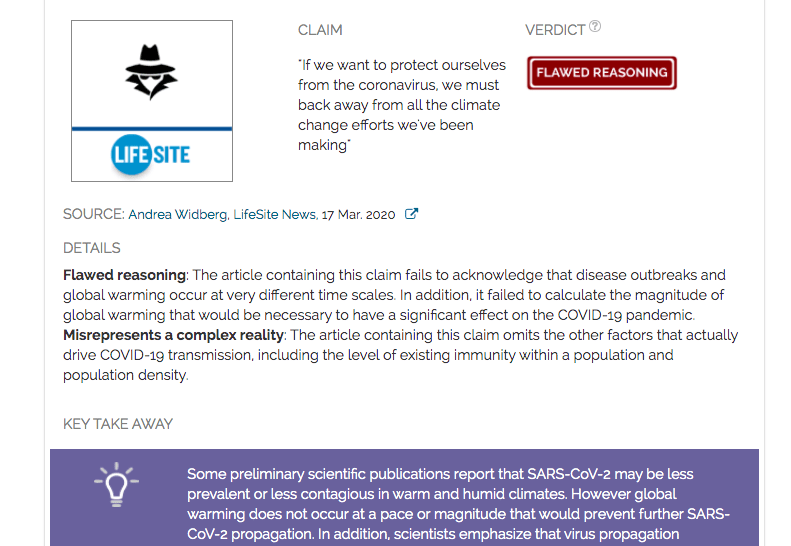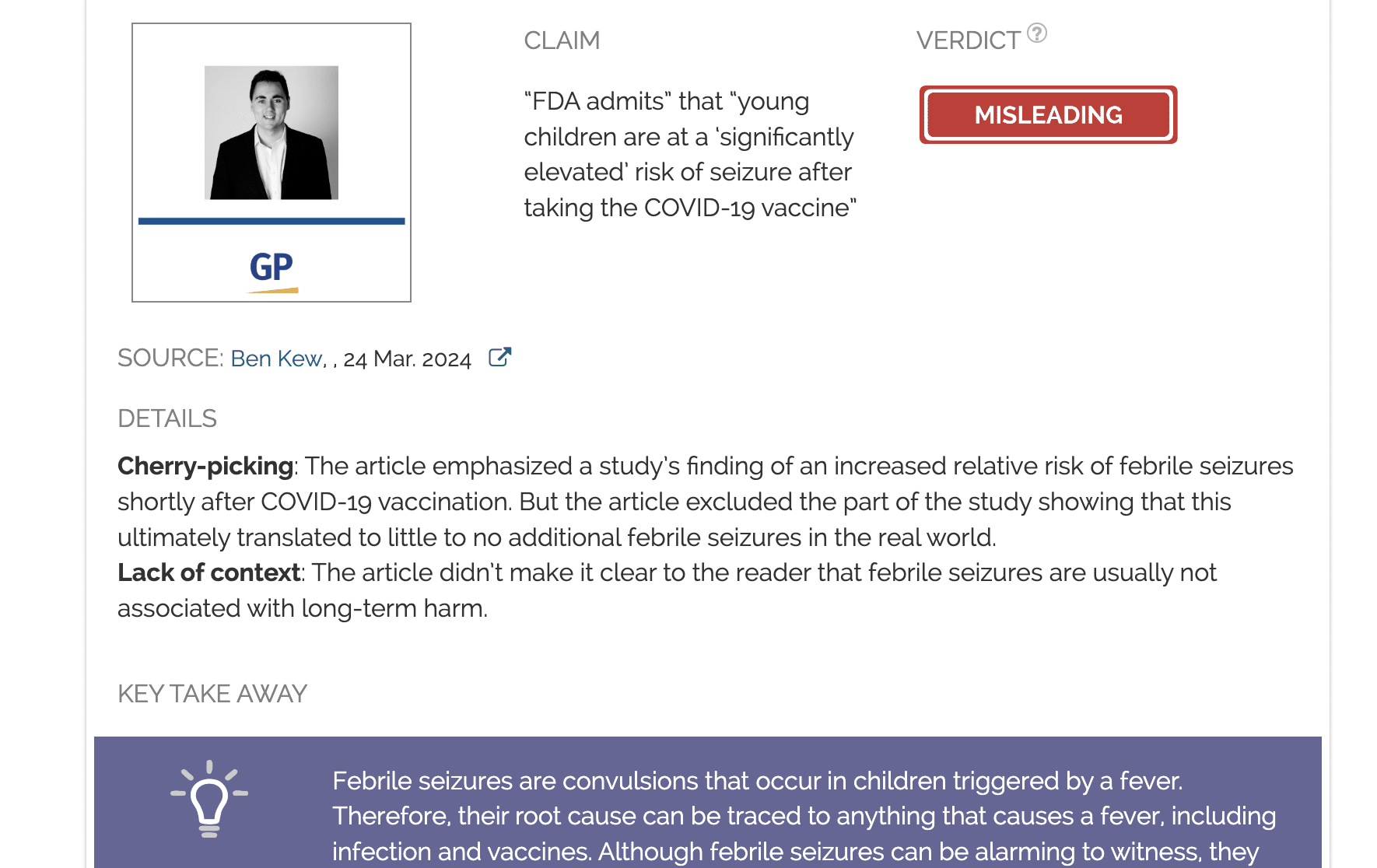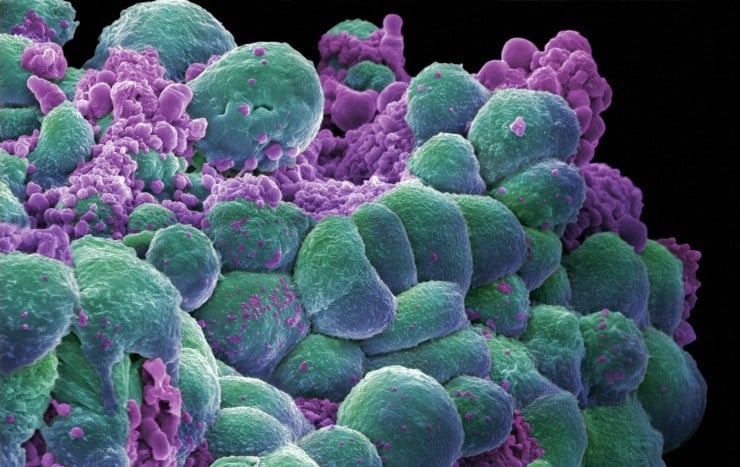- Climate
- Health
Global warming and the COVID-19 pandemic are unrelated issues: one will not protect us from the other
Key takeaway
Some preliminary scientific publications report that SARS-CoV-2 may be less prevalent or less contagious in warm and humid climates. However global warming does not occur at a pace or magnitude that would prevent further SARS-CoV-2 propagation. In addition, scientists emphasize that virus propagation primarily depends on other factors such as existing immunity and there is currently no way to reliably predict the spread of COVID-19 on a warmer Earth.
Reviewed content

Verdict:
Claim:
If we want to protect ourselves from the coronavirus, we must back away from all the climate change efforts we've been making
Verdict detail
Flawed reasoning: The article containing this claim fails to acknowledge that disease outbreaks and global warming occur at very different time scales. In addition, it failed to calculate the magnitude of global warming that would be necessary to have a significant effect on the COVID-19 pandemic.
Misrepresents a complex reality: The article containing this claim omits the other factors that actually drive COVID-19 transmission, including the level of existing immunity within a population and population density.
Full Claim
If we want to protect ourselves from the coronavirus, we must back away from all the climate change efforts we've been making
Summary
An article published on 17 March 2020 on Life Site News claims that “[i]f we want to protect ourselves from the coronavirus, we must back away from all the climate change efforts we’ve been making.” However, scientists who reviewed this claim unanimously reject this conclusion, explaining that global warming and virus seasonality are two phenomena of different time scales so that one cannot be harnessed to control the other. They also point out the paucity of data regarding SARS-CoV-2 transmission.
This claim is based on the unpublished findings of several research groups, which recently reported a possible effect of local temperature and humidity on the transmission of SARS-CoV-2, the coronavirus responsible for the current pandemic of COVID-19. A team in China published a preprint article comparing the transmission of SARS-CoV-2 in different Chinese cities, relating it to local temperature and humidity levels[1]. Their overall conclusion was that the virus is transmitted more efficiently in colder and drier environments. Similarly, a study led by researchers from the University of Maryland observed that most SARS-CoV-2 transmission occurs along a latitude corridor where temperatures averaged 5-11°C[2]. Based on these results, the author of the Life Site News article suggested that a warmer Earth would mitigate the transmission of SARS-CoV-2 and that stopping current efforts to limit global warming would be an appropriate response to COVID-19 propagation.
Scientists who reviewed this claim unanimously rejected this conclusion, citing flawed reasoning. It is true that certain viruses have a transmission advantage at certain times of the year. Examples of seasonality can be seen with the influenza virus and the respiratory syncytial virus which peak preferentially during colder months in temperate regions[3,4]. Many direct or indirect factors can explain seasonality. For example, UV radiation tends to be more intense during the warmer season, leading to more rapid deterioration of virus particles, while higher humidity may hamper their dissemination in the air, as explained in this news article by Science.
However, Prof. Mohammad Sajadi, a virologist at the University of Maryland School of Medicine and first author of one of the research pre-prints mentioned in the Life Site News article[2], specifies that “in tropical and subtropical regions, seasonal respiratory viruses can be present year-round and cause several peaks of infection”. Because the outbreak of COVID-19 is very recent, the data are still scant: “there is a chance that SARS-CoV-2 transmission will be somewhat weakened by summer temperatures if it behaves like the Influenza virus does, but at this point we really do not know enough to say that”, explains Dr. Devin Kirk who investigates the effect of climate change on infectious diseases at Stanford University. While some pre-print studies predict a decline in the rate of spread of COVID-19 in warmer climates, others disagree[5]. And recent outbreaks in tropical countries such as Singapore and Brazil confirm that temperature or humidity alone is not sufficient to prevent COVID-19 epidemics.
Consistently, several reviewers emphasized that other factors besides temperature or humidity are actually the dominant drivers of the current pandemic. “At this stage, the fact that there is no population immunity means we will likely see significant spread of the virus, even in warmer climates,” highlights Dr. Rachel Baker, a researcher in epidemiology and environmental studies at Princeton University.
Micaela Martinez, an infectious disease specialist at Columbia University, shares this view: “Currently, environmental factors, such as temperature and humidity, will likely be overridden by the fact that so much of the world is susceptible to this infection and can act as kindling to allow this pandemic to grow.“
Therefore, active efforts to mitigate virus propagation that target human behavior and to develop treatments are more likely to offer an effective solution. Even if the virus were less virulent under warmer or more humid conditions, it will still jump from one person to another in cases of close contact, warns Prof. Akiko Iwasaki, an immunobiologist at Yale University: “Even in warm and humid conditions, people should still wash hands and practice social distancing measures. If someone sneezes close to you, no amount of temperature and humidity can prevent droplet spray containing the virus from coming into contact with your face.”
The scientists who reviewed this claim also unanimously rejected the idea that allowing global warming to intensify may be a valid response to the COVID-19 pandemic. Global warming occurs at a completely different pace than the progression of epidemics. Current average global temperatures are 1°C higher relative to the early 20th century. This rise in Earth’s average temperature would therefore have no impact on disease epidemics “because there are significant lag times in the climate’s response to human behavior. Were we to cease climate change mitigation efforts now, the effects would only be felt 40 years down the line,” Dr. Baker says.
Finally, based on available data, there is inconsistency between the magnitude of global warming and the rise in temperature that would be required to stop SARS-CoV-2 transmission. One of the studies that the Life Site News article is based on reports that a 1°C increase in ambient temperature correlates with a 0.0383 decrease in the SARS-CoV-2 reproduction number (R0)@[1]. Recent reports suggest an initial average reproduction number of 2.8 to 3.8[6,7,8], while a meta-analysis indicates that the reproduction number of seasonal influenza is around 1.28[9]. Based on the same premises and publications referenced in the Life Site News article, and assuming a linear correlation, a staggering increase of between 39°C and 66°C would be required to reduce SARS-CoV-2 propagation down to the level of the seasonal flu if one were to solely rely on temperature. At this point, the Earth would be entirely uninhabitable to humans.
In conclusion, there is no basis whatsoever to claim that “backing away from climate change efforts” would help “protect ourselves from the coronavirus”.
Scientists’ Feedback

Assistant Professor, Mailman School of Public Health, Columbia University
In my expert opinion, as a specialist on infectious diseases seasonality and also a professor in climate change and human health, I can say that the logic behind this statement is inaccurate because:
- It is wrongly assuming that long-term changes in global surface temperature (i.e., climate change) are equivalent to changes in the weather seasonally. It is the weather (which operates on a shorter time scale) that is important to consider when evaluating transmission of coronavirus.
- We are still very early on in this pandemic and it will take multiple seasons (i.e., years) to properly evaluate how weather conditions may influence transmission. Currently, environmental factors, such as temperature and humidity, will likely be overridden by the fact that so much of the world is susceptible to this infection and can act as kindling to allow this pandemic to grow.

Associate Professor , University of Maryland School of Medicine
Those seeking to roll back climate change efforts in part because of our findings of the potential seasonality of the SARS-CoV-2 neither understand climate science nor virology. Seasonal viruses have the potential to significantly affect every part of the planet, but at different times[10,11,12,13]. In the Arabian Peninsula, MERS was unable to have significant community transmission (majority of outbreaks were in the hospital)[14]. The solution is not for everyone to go and live in a desert environment, or create a planet that is inhospitable to countless forms of life. I believe we can find a more efficient solution to this problem than ruining the planet for future generations.
[It] is our prediction, based on what we have seen thus far, [that regions with warmer/more humid climate will see less COVID-19 than colder/drier regions]. However, in tropical and subtropical regions, seasonal respiratory viruses can be present year round, and cause several peaks of infection, so a more accurate picture would be to do a yearly tally and comparison of the areas.From what I have read, with global warming, different areas will be affected differently. If the R0 [the basic reproduction number]@ will change with different temperatures as we hypothesize (and shown by a different group), then changes in the temperatures/humidity could increase risk for certain areas and decrease those for others.

Postdoctoral Research Associate, Princeton Environmental Institute
There appear to be two main themes in the article. One suggesting that if the virus is sensitive to temperature, we should abandon efforts to mitigate climate change. The second, suggesting some individual actions to promote sustainability such as reusable bags, straws, or taking public transport should be altered to lower individual risk.
To address the first theme: we currently have only a limited understanding of the virus’s link with climate drivers. However, other coronaviruses as well as influenza and RSV (respiratory syncytial virus) all exhibit seasonal cycles that appear to be climate-driven[4,15]. It may well be that the virus is sensitive to warmer temperatures. However, there are several other factors that also affect transmission. Most importantly, at this stage, the fact that there is no population immunity means we will likely see significant spread of the virus even in warmer climates. Furthermore, because there are significant lag times in the climate’s response to human behavior, were we to cease climate change mitigation efforts now the effects would only be felt 40 years down the line[16] — not the most practical option for helping limit the current pandemic.
To address the second theme: the virus has been shown to survive for hours to days, depending on the surface[17]. While there have been no specific studies on plastic bags versus cloth bags, my guess is carrying your own bag is less risky than touching a plastic bag that may have been sitting out in the store for days, with similar logic applying to straws. Of course, during this phase of the pandemic, individual changes to behavior are required to reduce disease transmission, including minimizing travel.

Postdoctoral Scholar, Stanford University
The author of [this claim] argues throughout the article that “if we want to protect ourselves from the coronavirus, we must back away from all the climate change efforts we’ve been making.”
There are several inaccuracies and illogical arguments throughout this article.
First, I’ll cover the foundation of their argument: the link between temperature and SARS-CoV-2 transmission. They use three different manuscripts to support their point that SARS-CoV-2 is negatively affected by warming temperatures. None of these three manuscripts are peer-reviewed, and each has what I would consider significant flaws that makes me doubt their conclusions. A couple notes on the different papers:
Wang, J. et al.[1]
- Their country-level analyses use number of cases, even though that is likely to depend more on timing since introduction or number of tests being run than climate.
- To determine the effects of summer weather on COVID-19 transmission, they are extrapolating far beyond their data to July temperatures.
- The pattern between temperature and transmission in Chinese cities here could easily be unimodal rather than the linear model they fit.
Sajadi, M. et al.[2]
- They claim that [COVID-19] is establishing in the 30-50 degree north corridor at similar weather patterns (5-11°C), and that there is a lack of establishment based on where there is travel and we should expect it.
- However, Scandinavia is getting cases and is out of this weather range, Mexico is out of this range and likely doesn’t have cases due to limited testing (according to the head of internal medicine at the ABC Medical Center in Mexico City), Australia is growing, Southeast Asia is growing now, Toronto isn’t in the weather range.
Wang, M. et al.[18]
- Epidemiological data and their R0 proxy are relatively limited, especially spatially.
- Weather data (using just the capital of a province) is limited.
- It does not appear they are controlling for factors like population size.
In summary, none of the three pre-print manuscripts the author relies on to link transmission to temperature are peer-reviewed and each has flaws in my opinion. There is a chance that SARS-CoV-2 transmission will be somewhat weakened by summer temperatures if it behaves like the Influenza virus does, but at this point we really do not know enough to say that. Moreover, this (also not yet peer-reviewed) pre-print analyzes data and finds that changes in temperature “will not necessarily lead to declines in COVID-19 case counts”[5].
At this point, there aren’t peer-reviewed papers regarding temperature’s effects on SARS-CoV-2, and we probably won’t know if it has an effect until temperatures really start to warm. I think the best explainer about what we do or do not know about temperature’s effects on SARS-CoV-2 is found in this blog post by Marc Lipsitch, the director of the Center for Communicable Disease Dynamics at Harvard. Marc Lipsitch is easily one of the global leaders in the field, so in my opinion that blog post carries a lot of weight. He concludes that seasonality will probably not lead the disease to go away on its own.
Finally, I just want to note the pretty ridiculous logical argument that if higher temperatures harm SARS-CoV-2 transmission (which, as I explain above, we do not know yet), this means that climate change is good for us to protect from the disease. This is a bad argument because climate change operates over a relatively very long time scale compared to the speed of this pandemic. Even if extremely high temperatures decreased viral transmission, we may need over a hundred years of global warming to get to those kinds of temperatures. It simply doesn’t make sense.

Professor, Yale School of Medicine
The claim that we should promote global warming to counter coronavirus is absurd. Global warming happens very slowly: 0.86°C increase [from] 1880 – 2012. Even if we did everything possible to increase global temperature fast, this will have dire consequences on Earth without having any impact on COVID-19 spread. While high temperature and humidity will likely reduce airborne transmission rate, the virus will still spread through direct contact or through contaminated surfaces. Even in warm and humid conditions, people should still wash hands and practice social distancing measures. If someone sneezes close to you, no amount of temperature and humidity can prevent droplet spray containing the virus from coming into contact with your face.

Professor, Mailman School of Public Health, Columbia University
There’s no basis for that assertion. Halting global warming will not stop the spread of this virus. Sounds like an effort to advance an anti-climate change agenda.
NOTES
@: The reproduction number R0 describes how many individuals a contagious person will infect. For instance, a R0 of 2 means that each person will on average infect two other individuals. The reproduction number is not a constant as it highly depends on the epidemiological and environmental context.
READ MORE
Full Fact also fact-checked similar claims that warmer weather will stop the outbreak of the novel coronavirus, explaining that “even if it ultimately turns out to be a seasonal virus, it is unlikely to behave like similar viruses in the short term. This is because it is so new that very few people are immune from it.”
Health Feedback has produced a number of other claim reviews on COVID-19. You can view them here.
REFERENCES
- 1 – Wang et al. (2020) High Temperature and High Humidity Reduce the Transmission of COVID-19. SSRN (pre-publication).
- 2 – Sajadi et al. (2020) Temperature, Humidity and Latitude Analysis to Predict Potential Spread and Seasonality for COVID-19. SSRN (pre-publication).
- 3 – Li et al. (2019) Global patterns in monthly activity of influenza virus, respiratory syncytial virus, parainfluenza virus, and metapneumovirus: a systematic analysis. The Lancet.
- 4 – Baker et al. (2019) Epidemic dynamics of respiratory syncytial virus in current and future climates. Nature Communications.
- 5 – Luo et al. The role of absolute humidity on transmission rates of the COVID-19 outbreak. medRxiv (pre-publication).
- 6 – Frieden and Lee. (2020) Identifying and Interrupting Superspreading Events—Implications for Control of Severe Acute Respiratory Syndrome Coronavirus 2. Emerging Infectious Diseases.
- 7 – Wang et al. (2020) Evolving Epidemiology and Impact of Non-pharmaceutical Interventions on the Outbreak of Coronavirus Disease 2019 in Wuhan, China. medRxiv (pre-publication).
- 8 – Liu et al. (2020) The reproductive number of COVID-19 is higher compared to SARS coronavirus. Journal of Travel Medicine.
- 9 – Biggerstaff et al. (2014) Estimates of the reproduction number for seasonal, pandemic, and zoonotic influenza: a systematic review of the literature. BMC Infectious Diseases.
- 10 – Viboud et al. (2006) Influenza in tropical regions. PLoS Medicine.
- 11 – Bloom-Feshbach et al. (2013) Latitudinal variations in seasonal activity of influenza and respiratory syncytial virus (RSV): a global comparative review. PLoS One.
- 12 – Li et al. (2019) Global patterns in monthly activity of influenza virus, respiratory syncytial virus, parainfluenza virus, and metapneumovirus: a systematic analysis. The Lancet Global Health.
- 13 – Tamerius et al. (2011) Global influenza seasonality: reconciling patterns across temperate and tropical regions. Environmental Health Perspectives.
- 14 – Memish et al. (2020) Middle East respiratory syndrome. The Lancet.
- 15 – Shaman and Kohn. (2009) Absolute humidity modulates influenza survival, transmission, and seasonality. Proceedings of the National Academy of Sciences.
- 16 – Hansen et al. (2005) Earth’s energy imbalance: Confirmation and implications. Science.
- 17 – Van Doremalen et al. (2020) Aerosol and Surface Stability of SARS-CoV-2 as Compared with SARS-CoV-1. New England Journal of Medicine.
- 18 – Wang et al. (2020) Temperature significant change COVID-19 Transmission in 429 cities. medRxiv (pre-publication).



